#maunderlust
Text
Making Some Changes
Hey, all, going forward I'm going to be using this tumblr to post all my meta, not just the Avengers stuff. But don't worry! I'm still going to be putting Avengers content here, except now it will be alongside other things I'm interested in and thinking about, and I'll still be reblogging the cool Avengers stuff y'all post on here.
I'm still deciding whether to change the name of my tumblr or not, so for now that remains sparklywaistcoat.
Whenever I post something here I will also post it to whichever of my WordPress blogs is relevant for my followers on there, and cross-linking it here in case anyone prefers to read longer-form stuff on WordPress rather than on tumblr. Comments and conversation will be welcome both here and on WordPress.
Here are the WordPress blogs (links below the cut):
Feather Dusters at 400 Yards (Avengers only, both fic and meta)
Maunderlust (books, film, and television, other than the Avengers).
A Dish of Orts (art, music, religion, politics, and life in general)
I'm also keeping my YouTube fanvid channel (link below the cut as well).
Thanks to all my mutuals for being here, and I look forward to having more interesting conversations with you!
#the avengers#meta#wordpress#blogging#maunderlust#feather dusters at 400 yards#a dish of orts#sparky waistcoat productions#youtube#fan vids
6 notes
·
View notes
Text
It originally manifested here: https://www.pinterest.com/Maunderlust/
0 notes
Text
Hey, y'all, here's a little something I cooked up about The Stepford Wives. I'd love to hear any thoughts you might have about it!
The Cishet Are Not Okay: The Stepford Wives as Queer Horror
The other night I attended a talk titled "Horror as Queer" by scholar and historian May Santiago. The talk covered the history of queerness in horror films, including a discussion of the differences between horror films that were made by queer creators and those that were made by creators who are/were not queer. It was an excellent talk, and really got the wheels turning in my head concerning The Stepford Wives, about which I am currently concocting a series of blogs.
There were two big points that Santiago made that really hit home for me with regard to my Stepford Wives project. The first point was the definition of horror as a reflection and representation of cultural anxieties. It's easy to see how this is true of The Stepford Wives, which first appeared as a book by Ira Levin (1972) and later as a film with a screenplay by William Goldman (1975). (There was also a film remake in 2004, but I won't be discussing that one here.) The anxieties on display in both the 1975 film and in Levin's book include unease over the burgeoning feminist movement and with the related issues of patriarchy, toxic masculinity, and gender roles, along with apprehension about the expanding roles of computer technology and automation. The film and the book likewise interrogate the perceived need to both acquire and conform to a certain level of social status, although this is more strongly presented in the film than in the book.
The second and more important main point of Santiago's talk—as can be seen from its title—is that queerness is always already embedded in horror as a genre because queerness and horror are both predicated on transgression of social and cultural norms. So this got me thinking: If The Stepford Wives is horror, then almost by definition it should also be queer, but how can something as aggressively patriarchal and cisheteronormative as The Stepford Wives be in any way queer horror?
[The rest of the blog is under the cut, or you can read it on my Maunderlust WordPress page]
The Stepford Husbands
The Stepford Wives stands apart from many other horror films in that there seems to be no obviously queercoded villain, monster, or other character that we can point to as the locus of queerness within the film. What Stepford does instead is to turn the underlying trope of queerness within horror on its head by making patriarchal cisheteronormativity the force for evil and strangeness within the film, effectively twisting that normativity to show it as essentially and fundamentally disordered. In Stepford—as so often in the real world—it's not the queer folks you have to be wary of, it's the cishet men.
Which brings us to the question of queerness within Stepford husband society: If what you want to bang is a robot, are you really straight, even if that robot is configured as the nominally "perfect" woman? Each of the men who comes to Stepford to get himself a perfect wife is eschewing a relationship with an actual human woman in favor of one with an extremely sophisticated robot. Because these robots are constructed to look like cis human females and programmed to perform variations on a very specific style of Western cisfeminine behavior, the Stepford men can pretend that they are still married to women, and therefore they can pretend that they are still in a cisheterosexual marriage, when in fact they are in a robosexual relationship. This means that their marriages potentially can be considered queer, if one applies the very broadest definition of "queer" as indicating relationships and/or gender identities that exist outside the bounds of standard cisheteronormativity.
Dale "Diz" Coba
The one character that we might see as queercoded if we tilt our heads and squint a little is Dale "Diz" Coba (Patrick O'Neal). In the film, Diz appears to be unmarried (he has a wife in the book), and the way he approaches Joanna Eberhart (Katharine Ross) in her kitchen when the Men's Association holds its meeting in her home doesn't seem to be the kind of behavior one might expect from a gay man, although theoretically Diz could be bi or ace. As we see in the progression of three stills below, Diz surprises Joanna as she tries to prepare refreshments for her guests, then gazes at her with a wolfish kind of appraisal. He is sizing her up and attempting to intimidate her with his masculine charm, and Joanna is indeed alarmed to find him there looming over her.
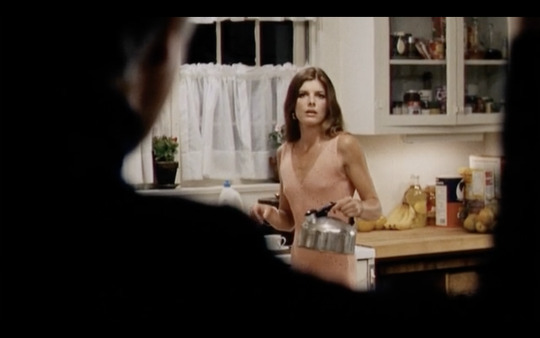


It's unclear whether Diz sees Joanna as sexually desirable for himself, or whether he only sees her as yet another stage in his project to turn all Stepford women in to robots. If the latter, then he only sees Joanna in terms of her potential for Stepfordization, rather than as a potential object for his own sexual gratification. And regardless of Diz's own sexual orientation, he wouldn't be the first serial killer to get off on the hunt and the kill, rather than on his victims themselves.
That said, whether Diz is queercoded or not is almost beside the point: he is clearly villain-coded, with his slick manner, penchant for dark-colored turtlenecks (the other men tend to wear light-colored button-down shirts), and darkened office with abstract, black-and-white art on the wall. He's also way sexier than any of the other Stepford men, so there's that as well.
Just as the film as a whole inverts the queerness-in-horror trope such that cisheteronormativity is the locus of strangeness and evil, so too does it create Diz's character such that any queerness we might sense from him is largely disconnected from his status as a villain. If all the men in Stepford are equally invested in murdering the women and turning them into robots, it honestly doesn't matter whether any of them are queer or not.
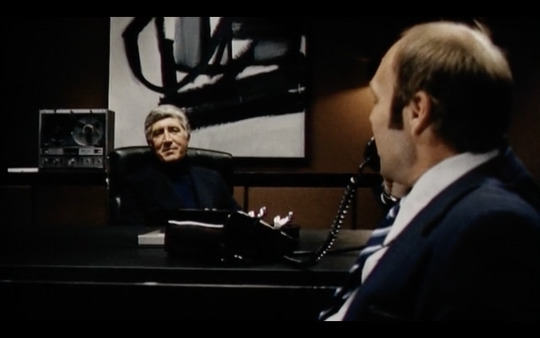

Further, Dale Coba's nickname, "Diz," is a reference to the fact that he used to work for Disneyland. The film's subtext suggests that Diz used to work in Disney's audioanimatronics division, creating animatronic characters for use in the Disney theme parks. (In the book, Diz's work on audioanimatronics is made explicit.) Diz has taken what he learned working for Disneyland and gathered around him a set of like-minded men who also are in the technology industry and who have the technical skills, money, and access to resources to pull off killing the women and replacing them with obedient androids.
In the film, this access to technology and tech facilities is shown when Bobbie and Joanna drive past a series of tech businesses, including Coba's own, while discussing what has happened to their friend, Charmaine, who just got Stepfordized herself:



Diz's nickname and employment history combine into yet another way that The Stepford Wives takes something that is strenuously normative—namely, the Walt Disney Company's films and theme parks—and turns it into something horrifying. Joanna certainly clocks Diz as a bad dude right away, saying, "You don't look like someone who enjoys making other people happy" when Diz tells her where he used to work. Disney villain, indeed.
Stepford Wives and Gender Nonconformity
While none of the yet-to-be-Stepfordized women characters would seem to be queer, Joanna Eberhart and her friend Bobbie Markowe (Paula Prentiss), at least, are painted as somewhat gender nonconforming prior to their Stepfordization. (The third human woman, Charmaine Wimperis, played by Tina Louise, seems not to be GNC.) The suggestion of gender nonconformity is achieved primarily through costuming choices, although with Bobbie there are additional GNC markers in her brash, tomboyish behavior and in her studied refusal to be a hausfrau before her transformation.
Although Joanna's demeanor is much more reserved and feminine than Bobbie's, she is most frequently dressed in trousers, jeans, or shorts prior to her transformation, as shown in this sample of stills from across the film:
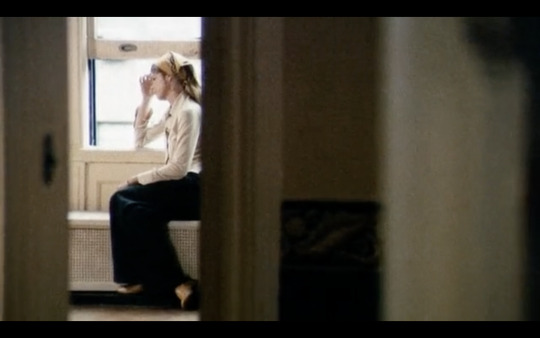

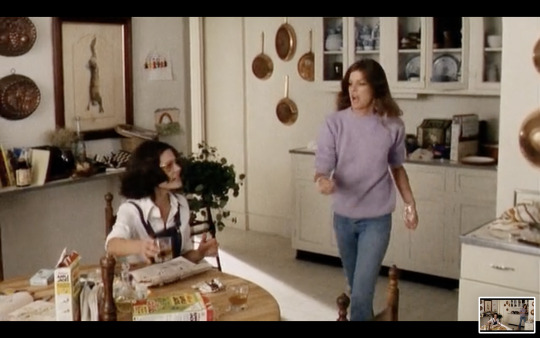

However, Joanna will don a dress if she is in a situation where she has to interact with men other than her husband, for example when the Men's Association meets at her house or when she goes to the big neighborhood barbecue at Diz's place:


Unlike with Joanna, we never see Bobbie in a skirt or a dress while she is a human woman. She only ever wears shorts, jeans, or trousers, and she seems especially fond of overalls, which adds to our perception of her as tomboyish:
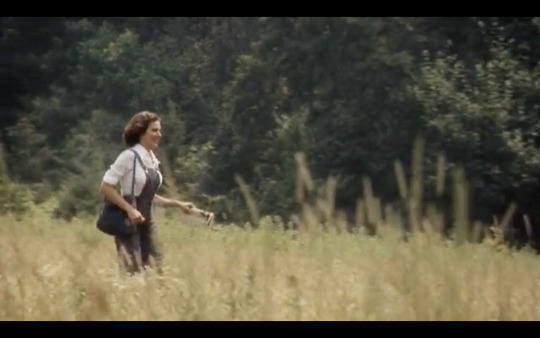

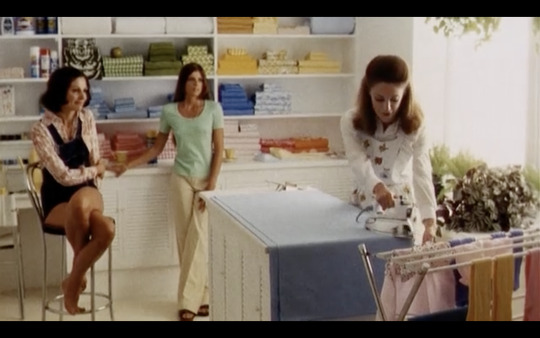
By contrast, the already-Stepfordized women we meet across the film only ever wear dresses or skirts, frequently of maxi length:



Bobbie only starts wearing dresses after she has become Stepfordized, and the change is especially stark with her, since she goes from vivacious tomboy in bib overalls to contented housewife in long skirts, lace, frills, and sometimes even plunging necklines that draw attention to her breasts:


Joanna's transformation with regard to costuming is a little less jarring than Bobbie's, but there is still a significant feminization of Joanna's mode of dress. In the final scene of the film, she's wearing a white sun hat, a white sleeveless dress with a pink sash, and white gloves:

Evidently part of an official Stepford wife's duties is to accept that your husband is the only one who wears the pants in the family, both literally and figuratively.
Although Joanna's and Bobbie's gender nonconformity is very mild, it still stands out in stark contrast to the hyperfemininity of the already-Stepfordized wives. Further, the film portrays Joanna's and Bobbie's pre-transformation gender presentations as both normal and healthy, including the fact that Bobbie's leans rather more GNC than Joanna's does. Here again the trope of queerness as a locus for horror has been turned on its head: the element of terror instead is a ruthless, forced adherence to very highly constructed and patriarchally determined cisheteronormative gender roles and gender presentations.
The Cishets Are Not Okay
So now we circle back around to the main question I proposed at the top of this blog: Is The Stepford Wives queer horror? I believe that the answer to this question is "yes," not despite the fact that it fails to conform to more common presentations of horror as queer, but rather because of the ways that it fails to conform to those standards.
The Stepford Wives is queer horror because it regards the rigorously normalized Stepford society—and, by extension, patriarchal cisheteronormativity itself—from an outsider's point of view. Instead of using queercoded monsters or villains to represent queerness as a disordered, monstrous, transgressive threat to the normative, The Stepford Wives posits that disorder, monstrousness, and transgression are actually the province of the normative itself, given that the normative hegemon has the power and the resources to work its will in ways that the marginalized and the disenfranchised do not, and often in ways that the marginalized and disenfranchised cannot escape. This is something that has been known by queer communities for as long as there have been queers, and it is this quality that allows us to see The Stepford Wives as inhabiting the queer horror space.
8 notes
·
View notes
Text
Welcome to my blog about The Avengers (no, not those Avengers, the REAL Avengers). Here is where I fangirl about John Steed, Cathy Gale, Emma Peel, and the actors that play them, along with the occasional off-topic post.
My long-form maunderings about The Avengers are here, along with fan vids, fan art, and fan fiction.
In my Good Omens sideblog incarnation I am aziraphales-frock-coat.
I also have a non-Avengers media meta WordPress page called Maunderlust, and another page that’s about whatever I feel like discussing at the moment called A Dish of Orts.
I automatically block the following:
porn, BDSM, gore, body horror, and blogs with NSFW avatars
pro ana/thinspo
conservatives, antivaxxers, antimaskers, gun nuts, and anyone who likes Trump
racists, ableists, fascists, homophobes, xenophobes, sexists, and transphobes
anyone who thinks that pedophilia and incest are “harmless,” whether in fiction or in real life
I am in my fifties, so if you are a youngun who is uncomfortable interacting with older adults, please do not like/reblog or follow.
23 notes
·
View notes